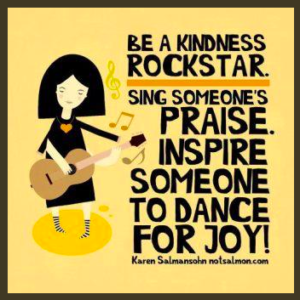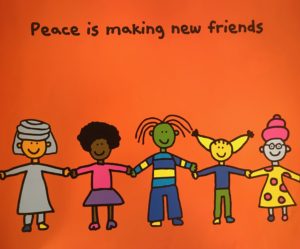 Be a kindness rock star! The poster on the left by Karen Salmansohn provides my motto for behavior management for music specialists or teaching artists or any adult who visits classrooms. (Substitute teachers, there is a special place in Heaven for you.)
Be a kindness rock star! The poster on the left by Karen Salmansohn provides my motto for behavior management for music specialists or teaching artists or any adult who visits classrooms. (Substitute teachers, there is a special place in Heaven for you.)
One of the biggest challenges for any teacher is that some kids just won’t behave themselves. It’s especially challenging for occasional teaching visitors to a classroom. We arrive with a perfectly-planned session of music, story-telling or theater, and these two – or three or ten – kids just don’t want to get with the program.
They act silly, roll on the floor, interrupt to say it’s raining outside, stand up, sit down, bash a friend (accidentally or on purpose), look sullen. Fill in the blank.
Experienced classroom teachers have their bag of tricks, but if that teacher leaves the room or even takes her eyes off what’s happening, chaos can descend. Sometimes it descends despite the everyone’s best efforts.
Your first instinct might be to scream “no” at offending parties while you resist more colorful language. You might threaten to send the bad kids away to a time-out corner or some other remote location.
But they might be the ones that most benefit from what you’re offering.
I wish I could say I’ve got the perfect solution. In two decades of mostly itinerant arts teaching, I’ve sometimes felt like a failure when the “class from hell” rains holy terror on my music session. It happens to the best of us.
But I’ve learned a few things, especially from two employers: a KIPP school and a Montessori school. KIPP is a charter school organization that specializes in success with at-risk populations; Montessori is an educational technique founded by Dr. Maria Montessori, encouraging children to take the lead in shaping their learning. KIPP and Montessori take different approaches to education, but they share common ground on behavior management.
It’s simple: Focus on the good. In Montessori, it’s called “grace and courtesy.”
Children are not born graceful and courteous. They start their lives screaming. Perhaps they’re innately good, but that doesn’t always translate to good behavior when they arrive at school.
They must be taught to behave properly. Sometimes families have started them off well, sometimes not. Whatever the children’s preparation, when they get to school or preschool, they need to be taught the expectations, and they need to practice. Over and over.
I was part of a team that founded a KIPP elementary school, and our first job was to create a school culture. As an organization, KIPP started with middle schools (because what could be more challenging than adolescence?) and targeted the toughest urban neighborhoods where schools were often failing. They expanded to high school, then started elementary schools because why not start at the very beginning?
At the KIPP school where I taught, in Lynn, MA, teachers spend several weeks with new kindergarten students teaching them to do simple things: sit down and stand up at the meeting rug and at your table, turn your eyes toward the speaker, get into a line and walk somewhere, show you agree with somebody without calling out, sit with a tall back and keep your hands in your lap. These norms are practiced again and again. When kids forget, they’re asked to go back and do it the right way.
The kids learn a silent way to send praise and support to others. It’s called “shine.” You simply hold your open hand out sideways, wiggle it and say, “I’m sending some shine to Carlos, who’s showing that he knows exactly the right way to sit safely on the rug.”
Our KIPP principal, Eveleen Hsu, often reminded us to “Go slow to go fast.” Meaning, take all those first steps of training the children slowly in how to act in school, eventually learning will go much faster.
You might be thinking that, as a “visiting artist,” you don’t have a chance to lay all this groundwork. Good schools might have already done some of the work for you. Over the years, I’ve been part of more than 30 schools and preschools. Some do a fantastic job of behavior management; others, not so much.
Those who serve at-risk populations have a tougher challenge. It’s hard for children to behave well if they’re hungry, feeling sick, facing neglect, stress or even trauma at home. There is a multiplier effect in classrooms filled with kids at risk – two or three miserable kids create stress for everyone else.
But back to being a kindness rock star. You’re the artist! You’re a special visitor – the best thing that’s happening all week! You can be a shining beacon of what’s good in the world. Here are a few recommendations for how to cement the kindness rock star vibe:
- Smile and be charming and confident from the get-go. Your positive energy is infectious and often spreads to those inclined not to be charming.
- Deliver copious praise to the kids who are doing the right thing, a subtle reminder of how others can imitate them. “These three people over here have been paying close attention, so they already know all the motions to the song! Yay!” Put focus on the goals of the class, not simply on people sitting still or keeping their hands in their laps.
- To those not getting with the program, it sometimes works well to praise the people right next to them. “Wow, child A, you’re sitting criss-cross so that your body is super safe!” (Child B quickly gets into line; they want some praise, too!)
- If a child is still acting out, speak to them softly. If possible, find a way to have a short, private conversation. If a classroom teacher is in the circle, sometimes the teacher can do that. It helps if you and the teacher can discuss potential problem students and plan a strategy in advance.
- If you can’t have a private conversation with a child in the moment, speak to the child in a way that’s positive. Instead of “No, Danny, don’t put your hand in Julie’s hair!” say, “Danny, we have more fun when we respect the people around us.” (And see if it’s possible to move Danny further from Julie, so that his wandering hands are less of an issue.)
- Take a moment. If things are quickly headed downhill, stop the momentum by just stopping. The kids will likely notice that you are silent and not moving. It works better than imitating their frenzy. The old technique of “If you can hear my voice (which is not loud), tap your nose…” etc. is a tried and true strategy. It can quickly shift the dynamic.
It is also important, of course, that your material be absolutely as engaging as you can make it. Have gimmicks up your sleeve. Kids love when I pull out a puppet or a glove starring all the fingers as characters. My friend who sings with toddlers says everything changes when she gets out that dancing wooden guy called a limber-jack.
Sometimes, whatever you do, it’s not enough. Know that you are not the cause of things going south. Continue practicing peace and kindness and you will win many fans, even if a few kids seem determined to drive you out of your mind.
I leave you with this picture, a creation by one of the teachers at the Montessori School where I currently work. It’s a Peace Corner. Sometimes everyone just needs a little peace. Providing a retreat to the kid who’s having a tough time is often the best solution for everyone.







You are right, Liz, that the children who are the most challenging are really the ones who need our kindness and our example of kindness. So often the difficult child is isolated from the group — kind of a silent exclusion – which always makes the problem worse.
I have found that more movement, more jumping, more spinning, helps. And I use my stopping cue with arms extended and moving across the body, windmill style: “Hands up! Tick, tock, goes the clock! Try to be as still as a rock!”
Great article, Liz. Rings true!
Wonderful article. I also have found it works to say what is going right! I love the photo of the peace book! At my website, http://www.plantingseedsoflove.com there are several activities on this topic, using gardening, games, making a book etc using the song Planting Seeds of Love. And it’s all free there. I’d love to see a photo of a teacher’s book of that song, made by kids.
Also, here is a link to the song, Kindness is Everywhere!
https://www.youtube.com/watch?v=xKDlAnJqMNc&t=12s
Great blog piece!
So true Liz. Another thing that I do is praise the “misbehavers” for the littlest things that they are doing right. These are often the kids that never get praise, because “doing it right” is extremely hard for them. The little praise for the minute of a classroom appropriate choice works magic for them, because they so rarely hear that!
The name of my disability awareness and inclusion program is “But First Do No Harm”….who knows what a kid is dealing with outside the hour that I am seeing them? If I assume that there is a reason for their behavior and I am there to help, not make it worse, my own attitude is more compassionate. And that goes a long way.
So glad I came across this blog through The Children’s Music Network listserve for members (become a member, everyone!), which is also where I met all the wonderful commentators above and also Liz!!
Liz, I love your blog and this article is wonderful.
Keep on singing beautiful and fun songs!
Thank you for these nice comments, Amy! I urge anyone reading this to join The Children’s Music Network!
After a “very bad day” this week, your ideas are a welcome reminder with some excellent ideas. Thank you for the inspiration to carry on.
Thank you, Beth! I hope that your “bad” days are few and far between! 😀